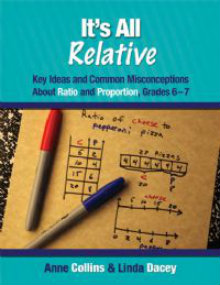What You Need to Explain Ratio and Proportion
It’s All Relative: Key Ideas and Common Misconceptions about Ratio and Proportion, Grades 6-7
By Anne Collins and Linda Dacey
(Stenhouse Publishers, 2014 – Learn more)
 Reviewed by Ashley Walther
Reviewed by Ashley Walther
Collins and Dacey delivered on the title of this practical guide to teaching ratios and proportions. Written for middle school math teachers, this book’s usefulness is not limited to the 6-8 grade band. Its organizational structure is easy to follow and each page is packed with ideas and information. This book is a must-read for any math teacher that encounters ratios and proportions in the classroom.
 The most obvious feature to mention about this book is that it is a flip chart. The flip chart design makes it easy to locate your favorite selections. In all, the book contains thirty classroom-ready activities. Each page of the chart includes five key sections: mathematical focus, potential challenges & misconceptions, in the classroom, meeting individual needs, and further reading.
The most obvious feature to mention about this book is that it is a flip chart. The flip chart design makes it easy to locate your favorite selections. In all, the book contains thirty classroom-ready activities. Each page of the chart includes five key sections: mathematical focus, potential challenges & misconceptions, in the classroom, meeting individual needs, and further reading.
Common Core aligned and much more
Readers will find the relevant Common Core standards for mathematics in the mathematical focus section. Only standards related to the activity are listed on each page. Potential challenges & misconceptions included helpful tips for teachers to consider when teaching ratio and proportion concepts. I found this section to be loaded with valuable information to keep in mind when planning lessons to teach the stated standards. In the classroom was typically the longest section on each page. That section described a suggested activity and occasionally included student work samples and observations from classrooms that had had the opportunity to test the activity.
One of the shorter but incredibly valuable sections was the meeting individual needs section. That section included information for supporting both struggling and advanced learners. I was pleased to see the authors did not neglect the students that needed an extra challenge. The final section was just as it sounds—further reading suggestions. Each page was organized in the same way and so it was easy to find information without having to wade through pages of text. The authors did an excellent job of presenting the information in a concise, neat package.
For teachers with a fair grasp of the content
One minor drawback of this flip chart is that it assumed the readers had a fair grasp on the mathematical content prior to reading the book. For that reason, I would not recommend this book to teachers that need help understanding the mathematical content. However, if the reader has a fair grasp of the content, this book will certainly help strengthen conceptual understanding and provide activities to facilitate the same understanding for students.
So many activities to engage students
One aspect of this book that I really loved was the variety of activities. The authors included games, discussions, investigations, kinesthetic activities, presentations, and so much more. It was refreshing to read each page and experience a different idea about how to engage students. One of the best gems that the authors included: black line masters for all of the activities. The authors truly did provide ready-to-use, classroom-tested activities.
Even though the activities are presented in a linear fashion, they do not rely on previous activities in this text. Any of the pages could be selected and implemented in isolation. Some activities do rely on a deeper level of prior conceptual understanding. Therefore, like any other well-planned lesson, teachers should certainly pay attention to what prior knowledge is required in each activity before implementing. This, in my opinion, was a strength of this book. By providing readers with stand-alone lessons, they made the book more user friendly and useful. Not every teacher has time to implement an entire pre-planned unit; however, all teachers can find time to try a single lesson.
Practical advice to reach a variety of learners
In summary, if you are looking for a book that is packed with activities to foster conceptual understanding of ratios and proportions in students, this is the book for you. The authors provide practical and useful advice to support all varieties of learners. All thirty of the included activities are ready to use. I recommend that all mathematics teachers read this book prior to teaching ratios and proportions—particularly 6th and 7th grade teachers.
Ashley Walther is a secondary numeracy coach for a middle school in Knoxville, Tennessee. She is currently pursuing a Ph.D. in Mathematics Teacher Education at the University of Tennessee—Knoxville. She has experience teaching both middle and high school mathematics.































